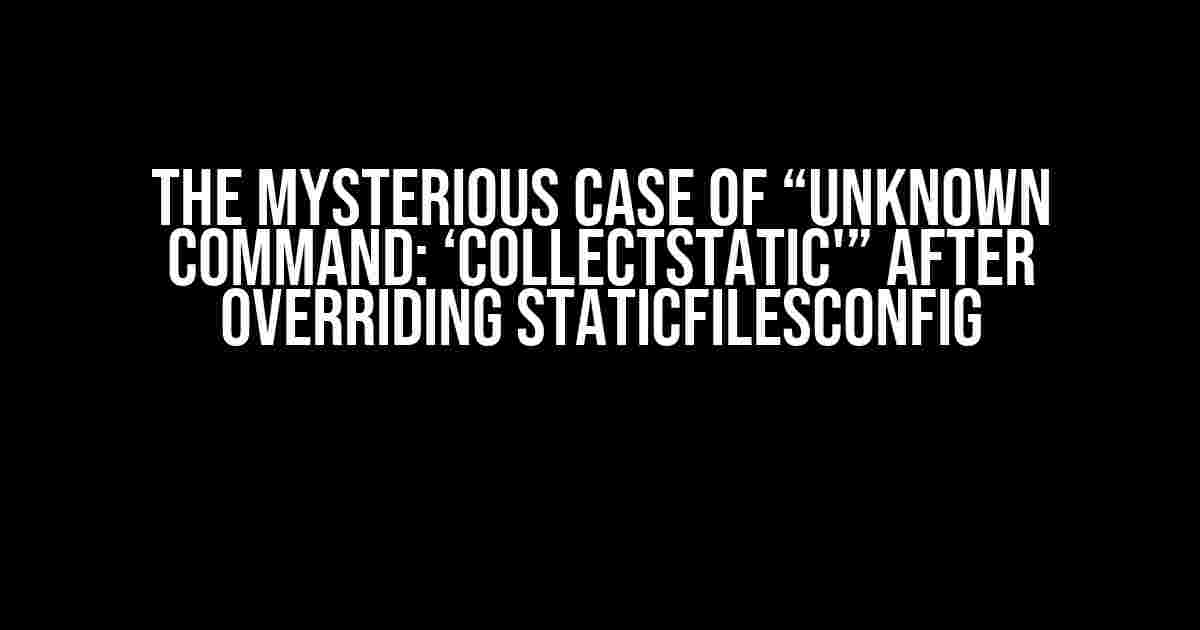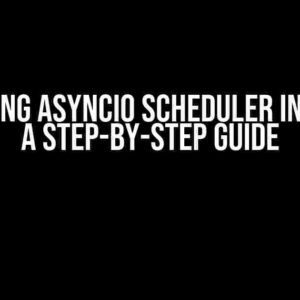Have you ever encountered the dreaded “Unknown command: ‘collectstatic'” error after overriding the StaticFilesConfig in your Django project? Don’t worry, you’re not alone! In this article, we’ll embark on a thrilling adventure to unravel the mystery behind this error and provide a step-by-step guide to resolve it.
What is StaticFilesConfig and why do I need to override it?
In Django, StaticFilesConfig is a built-in configuration class responsible for serving static files, such as CSS, JavaScript, and image files. By default, Django serves static files from the `static` directory within each app. However, you might need to override StaticFilesConfig to customize the static file serving behavior, for instance, to serve files from a different location or to use a CDN.
When you override StaticFilesConfig, you can specify a custom `staticfiles_dirs` attribute to define additional directories containing static files. This is where the trouble begins.
The “Unknown command: ‘collectstatic'” Error
After overriding StaticFilesConfig, you might encounter the following error when running the `collectstatic` command:
Unknown command: 'collectstatic' Type 'manage.py help' for usage.
This error occurs because Django’s `collectstatic` command relies on the `StaticFilesConfig` class to discover and collect static files. When you override this class, you inadvertently break the `collectstatic` command.
Step-by-Step Solution
Don’t worry; resolving this issue is relatively straightforward. Follow these steps to get your `collectstatic` command up and running again:
-
Check your project structure
Make sure your project structure is correct, with a `manage.py` file at the top level and an `settings.py` file within your project directory.
-
Verify your overridden StaticFilesConfig
Double-check that you’ve correctly overridden the `StaticFilesConfig` class in your `settings.py` file. Ensure that you’ve defined the `staticfiles_dirs` attribute correctly:
from django.contrib.staticfiles.storage import staticfiles_storage from django.conf import settings class MyStaticFilesConfig(staticfiles_storage.StaticFilesStorage): staticfiles_dirs = [os.path.join(BASE_DIR, 'my_static_folder')] -
Update your settings.py file
In your `settings.py` file, add the following code to define a custom `collectstatic` command:
from django.core.management.commands.collectstatic import Command as CollectStaticCommand class MyCollectStaticCommand(CollectStaticCommand): def __init__(self, *args, **kwargs): super().__init__(*args, **kwargs) self.staticfiles_storage = MyStaticFilesConfig() command_name = 'collectstatic' app_name = 'my_app' def get_commands(): return [command_name] commands = get_commands() -
Register the custom command
In your `settings.py` file, add the following code to register the custom `collectstatic` command:
from django.core.management import execute_from_command_line def main(): execute_from_command_line([sys.argv[0], command_name]) if __name__ == '__main__': main()
Additional Tips and Tricks
To avoid common pitfalls, keep the following tips in mind:
-
Use the correct directory structure
Ensure that your `my_static_folder` directory is correctly structured, with subdirectories for each static file type (e.g., `css`, `js`, and `img`).
-
Specify the correct `staticfiles_dirs` attribute
Double-check that the `staticfiles_dirs` attribute is correctly defined, including the path to your custom static folder.
-
Use the correct storage engine
Make sure to use the correct storage engine for your static files. In this example, we used `staticfiles_storage.StaticFilesStorage`.
Conclusion
The “Unknown command: ‘collectstatic'” error can be frustrating, but by following these steps and tips, you should be able to resolve the issue and get your `collectstatic` command working again. Remember to carefully review your project structure, overridden StaticFilesConfig, and custom command registration.
With this comprehensive guide, you’ll be well-equipped to tackle the mysteries of Django’s static file serving and provide a seamless experience for your users.
| Troubleshooting Checklist |
|---|
| Verify project structure |
| Check overridden StaticFilesConfig |
| Update settings.py file with custom collectstatic command |
| Register custom command |
| Review directory structure and staticfiles_dirs attribute |
| Use correct storage engine |
By following this checklist, you’ll be able to identify and resolve the “Unknown command: ‘collectstatic'” error, ensuring that your Django project serves static files efficiently and effectively.
Frequently Asked Question
Getting stuck with “Unknown command: 'collectstatic'” error after overriding StaticFilesConfig? Don’t worry, we’ve got you covered! Here are some frequently asked questions and answers to help you troubleshoot the issue.
Q1: What is the main reason behind the “Unknown command: 'collectstatic'” error?
The primary reason behind this error is that Django cannot find the collectstatic management command. This usually happens when you have overridden the StaticFilesConfig and forgotten to include the collectstatic command in your new class.
Q2: How do I include the collectstatic command in my overridden StaticFilesConfig?
To include the collectstatic command, you need to import the Command class from django.contrib.staticfiles.management.commands.collectstatic and add it to your new class. For example: from django.contrib.staticfiles.management.commands.collectstatic import Command as CollectstaticCommand, and then add CollectstaticCommand to your new class.
Q3: What if I am using a custom management command in my overridden StaticFilesConfig?
If you are using a custom management command, you need to ensure that it is properly registered in your new class. You can do this by importing the Command class from django.core.management.base and registering your custom command using the @register.command decorator.
Q4: How do I troubleshoot the “Unknown command: 'collectstatic'” error in my Django project?
To troubleshoot the error, first, check if you have overridden the StaticFilesConfig correctly. Then, verify that the collectstatic command is included in your new class. If you are still facing issues, try running the command with the –verbosity 2 flag to get more detailed output.
Q5: What are some best practices to avoid the “Unknown command: 'collectstatic'” error in the future?
To avoid this error in the future, always double-check your overridden StaticFilesConfig to ensure that the collectstatic command is included. Also, make sure to test your custom management commands thoroughly to catch any potential issues early on.




